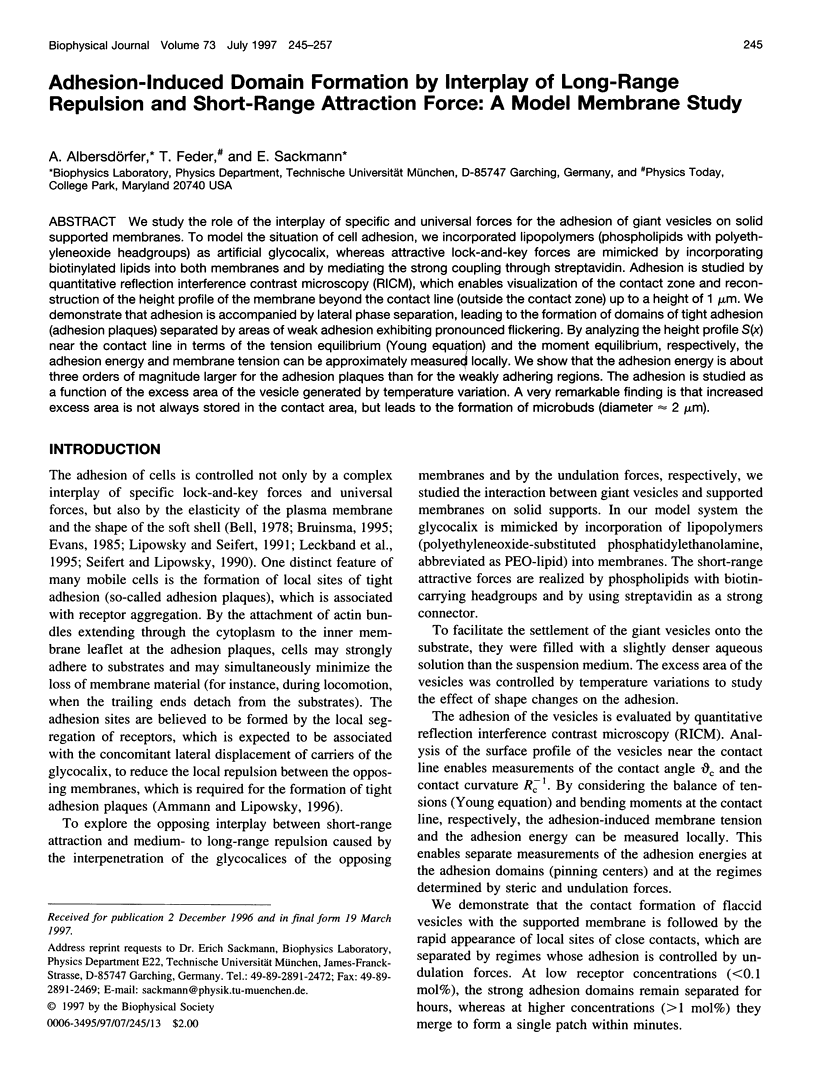Adhesion-induced domain formation by interplay of long-range repulsion and short-range attraction force: a model membrane study (original) (raw)
Abstract
We study the role of the interplay of specific and universal forces for the adhesion of giant vesicles on solid supported membranes. To model the situation of cell adhesion, we incorporated lipopolymers (phospholipids with polyethyleneoxide headgroups) as artificial glycocalix, whereas attractive lock-and-key forces are mimicked by incorporating biotinylated lipids into both membranes and by mediating the strong coupling through streptavidin. Adhesion is studied by quantitative reflection interference contrast microscopy (RICM), which enables visualization of the contact zone and reconstruction of the height profile of the membrane beyond the contact line (outside the contact zone) up to a height of 1 micron. We demonstrate that adhesion is accompanied by lateral phase separation, leading to the formation of domains of tight adhesion (adhesion plaques) separated by areas of weak adhesion exhibiting pronounced flickering. By analyzing the height profile S(x) near the contact line in terms of the tension equilibrium (Young equation) and the moment equilibrium, respectively, the adhesion energy and membrane tension can be approximately measured locally. We show that the adhesion energy is about three orders of magnitude larger for the adhesion plaques than for the weekly adhering regions. The adhesion is studied as a function of the excess area of the vesicle generated by temperature variation. A very remarkable finding is that increased excess area is not always stored in the contact area, but leads to the formation of microbuds (diameter approximately 2 microns).

Images in this article
Selected References
These references are in PubMed. This may not be the complete list of references from this article.
- Bell G. I. Models for the specific adhesion of cells to cells. Science. 1978 May 12;200(4342):618–627. doi: 10.1126/science.347575. [DOI] [PubMed] [Google Scholar]
- Blankenburg R., Meller P., Ringsdorf H., Salesse C. Interaction between biotin lipids and streptavidin in monolayers: formation of oriented two-dimensional protein domains induced by surface recognition. Biochemistry. 1989 Oct 3;28(20):8214–8221. doi: 10.1021/bi00446a037. [DOI] [PubMed] [Google Scholar]
- Bruinsma R., Goulian M., Pincus P. Self-assembly of membrane junctions. Biophys J. 1994 Aug;67(2):746–750. doi: 10.1016/S0006-3495(94)80535-1. [DOI] [PMC free article] [PubMed] [Google Scholar]
- Chiruvolu S., Walker S., Israelachvili J., Schmitt F. J., Leckband D., Zasadzinski J. A. Higher order self-assembly of vesicles by site-specific binding. Science. 1994 Jun 17;264(5166):1753–1756. doi: 10.1126/science.8209255. [DOI] [PubMed] [Google Scholar]
- Darst S. A., Ahlers M., Meller P. H., Kubalek E. W., Blankenburg R., Ribi H. O., Ringsdorf H., Kornberg R. D. Two-dimensional crystals of streptavidin on biotinylated lipid layers and their interactions with biotinylated macromolecules. Biophys J. 1991 Feb;59(2):387–396. doi: 10.1016/S0006-3495(91)82232-9. [DOI] [PMC free article] [PubMed] [Google Scholar]
- Evans E. A. Detailed mechanics of membrane-membrane adhesion and separation. I. Continuum of molecular cross-bridges. Biophys J. 1985 Jul;48(1):175–183. doi: 10.1016/S0006-3495(85)83770-X. [DOI] [PMC free article] [PubMed] [Google Scholar]
- Evans E. A., Parsegian V. A. Energetics of membrane deformation and adhesion in cell and vesicle aggregation. Ann N Y Acad Sci. 1983;416:13–33. doi: 10.1111/j.1749-6632.1983.tb35176.x. [DOI] [PubMed] [Google Scholar]
- Evans E., Berk D., Leung A. Detachment of agglutinin-bonded red blood cells. I. Forces to rupture molecular-point attachments. Biophys J. 1991 Apr;59(4):838–848. doi: 10.1016/S0006-3495(91)82296-2. [DOI] [PMC free article] [PubMed] [Google Scholar]
- Goldmann W. H., Ezzell R. M., Adamson E. D., Niggli V., Isenberg G. Vinculin, talin and focal adhesions. J Muscle Res Cell Motil. 1996 Feb;17(1):1–5. doi: 10.1007/BF00140319. [DOI] [PubMed] [Google Scholar]
- Green N. M. Avidin. Adv Protein Chem. 1975;29:85–133. doi: 10.1016/s0065-3233(08)60411-8. [DOI] [PubMed] [Google Scholar]
- Käs J., Sackmann E. Shape transitions and shape stability of giant phospholipid vesicles in pure water induced by area-to-volume changes. Biophys J. 1991 Oct;60(4):825–844. doi: 10.1016/S0006-3495(91)82117-8. [DOI] [PMC free article] [PubMed] [Google Scholar]
- Leckband D., Müller W., Schmitt F. J., Ringsdorf H. Molecular mechanisms determining the strength of receptor-mediated intermembrane adhesion. Biophys J. 1995 Sep;69(3):1162–1169. doi: 10.1016/S0006-3495(95)79990-8. [DOI] [PMC free article] [PubMed] [Google Scholar]
- Lipowsky R. Adhesion of Membranes via Anchored Stickers. Phys Rev Lett. 1996 Aug 19;77(8):1652–1655. doi: 10.1103/PhysRevLett.77.1652. [DOI] [PubMed] [Google Scholar]
- Noppl-Simson D. A., Needham D. Avidin-biotin interactions at vesicle surfaces: adsorption and binding, cross-bridge formation, and lateral interactions. Biophys J. 1996 Mar;70(3):1391–1401. doi: 10.1016/S0006-3495(96)79697-2. [DOI] [PMC free article] [PubMed] [Google Scholar]
- Rädler JO, Feder TJ, Strey HH, Sackmann E. Fluctuation analysis of tension-controlled undulation forces between giant vesicles and solid substrates. Phys Rev E Stat Phys Plasmas Fluids Relat Interdiscip Topics. 1995 May;51(5):4526–4536. doi: 10.1103/physreve.51.4526. [DOI] [PubMed] [Google Scholar]
- Seifert U, Lipowsky R. Adhesion of vesicles. Phys Rev A. 1990 Oct 15;42(8):4768–4771. doi: 10.1103/physreva.42.4768. [DOI] [PubMed] [Google Scholar]